Xiao-Lei Zhang
MDD: a Mask Diffusion Detector to Protect Speaker Verification Systems from Adversarial Perturbations
Aug 26, 2025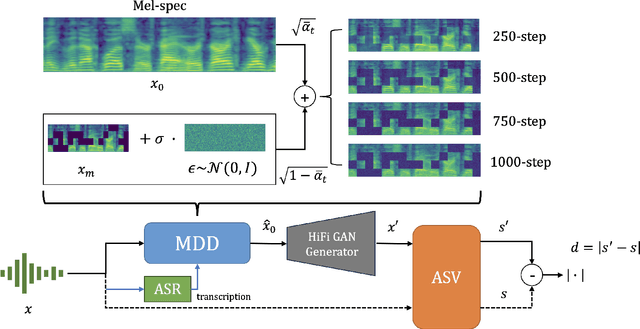
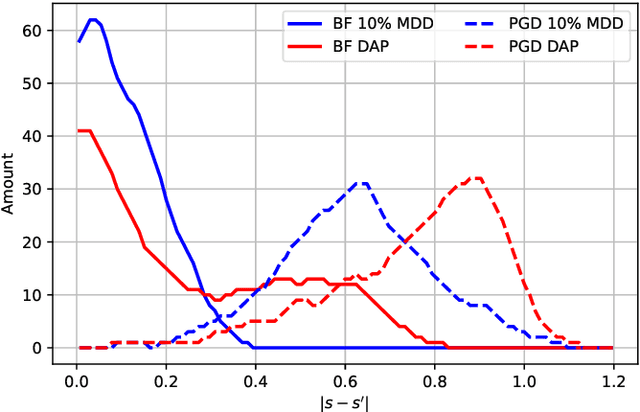
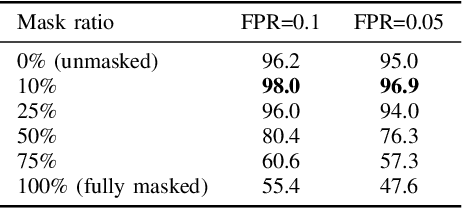

Abstract:Speaker verification systems are increasingly deployed in security-sensitive applications but remain highly vulnerable to adversarial perturbations. In this work, we propose the Mask Diffusion Detector (MDD), a novel adversarial detection and purification framework based on a \textit{text-conditioned masked diffusion model}. During training, MDD applies partial masking to Mel-spectrograms and progressively adds noise through a forward diffusion process, simulating the degradation of clean speech features. A reverse process then reconstructs the clean representation conditioned on the input transcription. Unlike prior approaches, MDD does not require adversarial examples or large-scale pretraining. Experimental results show that MDD achieves strong adversarial detection performance and outperforms prior state-of-the-art methods, including both diffusion-based and neural codec-based approaches. Furthermore, MDD effectively purifies adversarially-manipulated speech, restoring speaker verification performance to levels close to those observed under clean conditions. These findings demonstrate the potential of diffusion-based masking strategies for secure and reliable speaker verification systems.
PadAug: Robust Speaker Verification with Simple Waveform-Level Silence Padding
Aug 20, 2025Abstract:The presence of non-speech segments in utterances often leads to the performance degradation of speaker verification. Existing systems usually use voice activation detection as a preprocessing step to cut off long silence segments. However, short silence segments, particularly those between speech segments, still remain a problem for speaker verification. To address this issue, in this paper, we propose a simple wave-level data augmentation method, \textit{PadAug}, which aims to enhance the system's robustness to silence segments. The core idea of \textit{PadAug} is to concatenate silence segments with speech segments at the waveform level for model training. Due to its simplicity, it can be directly applied to the current state-of-the art architectures. Experimental results demonstrate the effectiveness of the proposed \textit{PadAug}. For example, applying \textit{PadAug} to ResNet34 achieves a relative equal error rate reduction of 5.0\% on the voxceleb dataset. Moreover, the \textit{PadAug} based systems are robust to different lengths and proportions of silence segments in the test data.
Angle-distance decomposition based on deep learning for active sonar detection
Jul 28, 2025Abstract:Underwater target detection using active sonar constitutes a critical research area in marine sciences and engineering. However, traditional signal processing methods face significant challenges in complex underwater environments due to noise, reverberation, and interference. To address these issues, this paper presents a deep learning-based active sonar target detection method that decomposes the detection process into separate angle and distance estimation tasks. Active sonar target detection employs deep learning models to predict target distance and angle, with the final target position determined by integrating these estimates. Limited underwater acoustic data hinders effective model training, but transfer learning and simulation offer practical solutions to this challenge. Experimental results verify that the method achieves effective and robust performance under challenging conditions.
Bridging the Gap between Continuous and Informative Discrete Representations by Random Product Quantization
Apr 07, 2025Abstract:Self-supervised learning has become a core technique in speech processing, but the high dimensionality of its representations makes discretization essential for improving efficiency. However, existing discretization methods still suffer from significant information loss, resulting in a notable performance gap compared to continuous representations. To overcome these limitations, we propose two quantization-based discretization methods: Product Quantization (PQ) and Random Product Quantization (RPQ). PQ partitions the original feature space into multiple subspaces and independently quantizes each sub-vector, producing a fused set of discrete units that retain diverse information from different subspaces, thus mitigating the loss associated with single-cluster quantization. RPQ further enhances representation diversity by randomly sampling a fixed proportion of feature dimensions multiple times to construct sub-vectors, thereby better capturing the variability in the data distribution. Theoretical analysis shows that RPQ reduces the correlation coefficient rho (where 0 <= rho <= 1) between sub-quantizers. Its quantization error is lower-bounded by the product of rho and epsilon-kms, where epsilon-kms denotes the quantization error of a single K-means quantizer. Experimental results on a combined dataset built from LibriSpeech and ML-SUPERB show that PQ and RPQ outperform standard K-means discretization, achieving relative improvements of 21.8 percent and 20.0 percent in WER on LibriSpeech, and 24.1 percent and 19.6 percent in CER on ML-SUPERB, respectively. Moreover, their performance is competitive with, and in some cases even surpasses, that of continuous SSL representations.
DualSpec: Text-to-spatial-audio Generation via Dual-Spectrogram Guided Diffusion Model
Feb 26, 2025Abstract:Text-to-audio (TTA), which generates audio signals from textual descriptions, has received huge attention in recent years. However, recent works focused on text to monaural audio only. As we know, spatial audio provides more immersive auditory experience than monaural audio, e.g. in virtual reality. To address this issue, we propose a text-to-spatial-audio (TTSA) generation framework named DualSpec.Specifically, it first trains variational autoencoders (VAEs) for extracting the latent acoustic representations from sound event audio. Then, given text that describes sound events and event directions, the proposed method uses the encoder of a pretrained large language model to transform the text into text features. Finally, it trains a diffusion model from the latent acoustic representations and text features for the spatial audio generation. In the inference stage, only the text description is needed to generate spatial audio. Particularly, to improve the synthesis quality and azimuth accuracy of the spatial sound events simultaneously, we propose to use two kinds of acoustic features. One is the Mel spectrograms which is good for improving the synthesis quality, and the other is the short-time Fourier transform spectrograms which is good at improving the azimuth accuracy. We provide a pipeline of constructing spatial audio dataset with text prompts, for the training of the VAEs and diffusion model. We also introduce new spatial-aware evaluation metrics to quantify the azimuth errors of the generated spatial audio recordings. Experimental results demonstrate that the proposed method can generate spatial audio with high directional and event consistency.
UniForm: A Unified Diffusion Transformer for Audio-Video Generation
Feb 08, 2025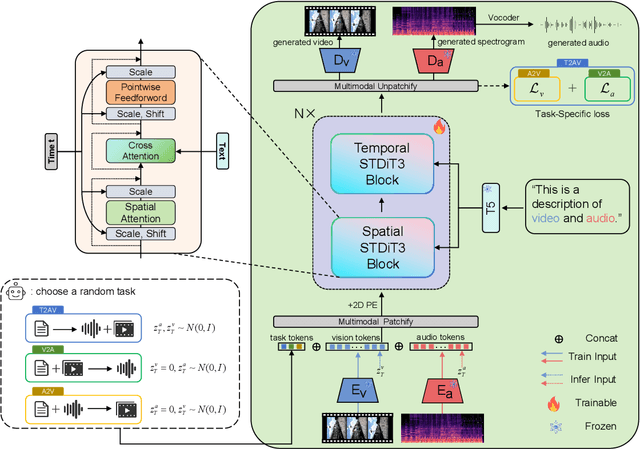

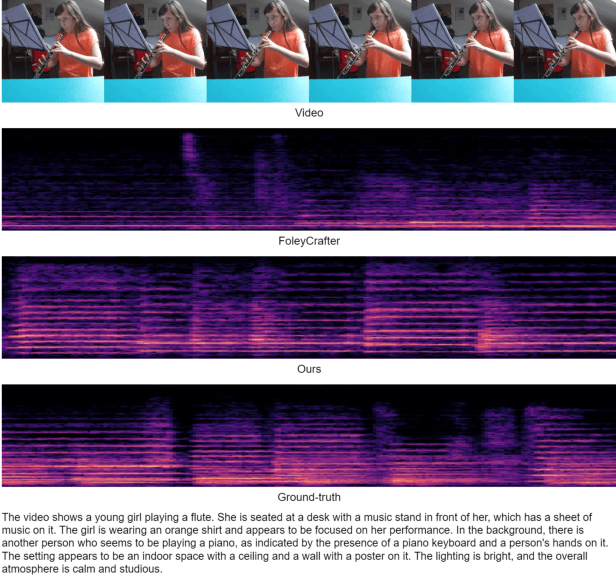

Abstract:As a natural multimodal content, audible video delivers an immersive sensory experience. Consequently, audio-video generation systems have substantial potential. However, existing diffusion-based studies mainly employ relatively independent modules for generating each modality, which lack exploration of shared-weight generative modules. This approach may under-use the intrinsic correlations between audio and visual modalities, potentially resulting in sub-optimal generation quality. To address this, we propose UniForm, a unified diffusion transformer designed to enhance cross-modal consistency. By concatenating auditory and visual information, UniForm learns to generate audio and video simultaneously within a unified latent space, facilitating the creation of high-quality and well-aligned audio-visual pairs. Extensive experiments demonstrate the superior performance of our method in joint audio-video generation, audio-guided video generation, and video-guided audio generation tasks. Our demos are available at https://uniform-t2av.github.io/.
Enhancing Intelligibility for Generative Target Speech Extraction via Joint Optimization with Target Speaker ASR
Jan 24, 2025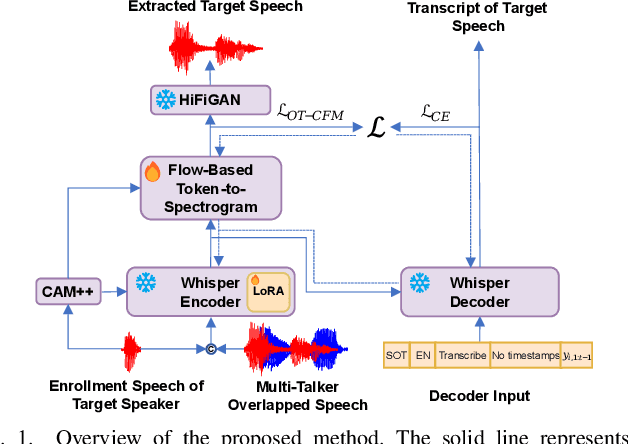
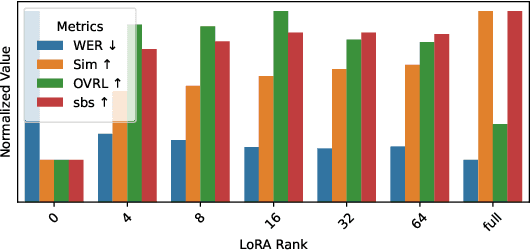
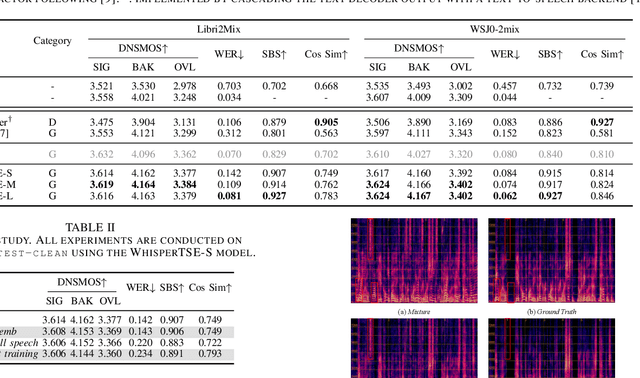
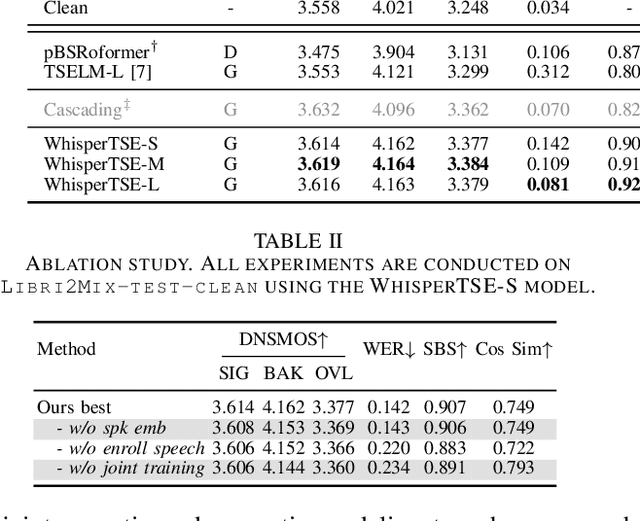
Abstract:Target speech extraction (TSE) isolates the speech of a specific speaker from a multi-talker overlapped speech mixture. Most existing TSE models rely on discriminative methods, typically predicting a time-frequency spectrogram mask for the target speech. However, imperfections in these masks often result in over-/under-suppression of target/non-target speech, degrading perceptual quality. Generative methods, by contrast, re-synthesize target speech based on the mixture and target speaker cues, achieving superior perceptual quality. Nevertheless, these methods often overlook speech intelligibility, leading to alterations or loss of semantic content in the re-synthesized speech. Inspired by the Whisper model's success in target speaker ASR, we propose a generative TSE framework based on the pre-trained Whisper model to address the above issues. This framework integrates semantic modeling with flow-based acoustic modeling to achieve both high intelligibility and perceptual quality. Results from multiple benchmarks demonstrate that the proposed method outperforms existing generative and discriminative baselines. We present speech samples on our demo page.
Speaker Contrastive Learning for Source Speaker Tracing
Sep 16, 2024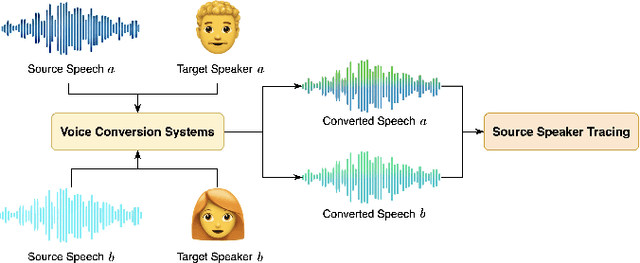
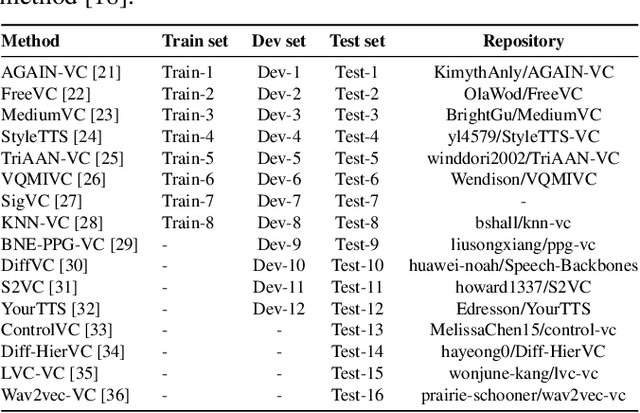
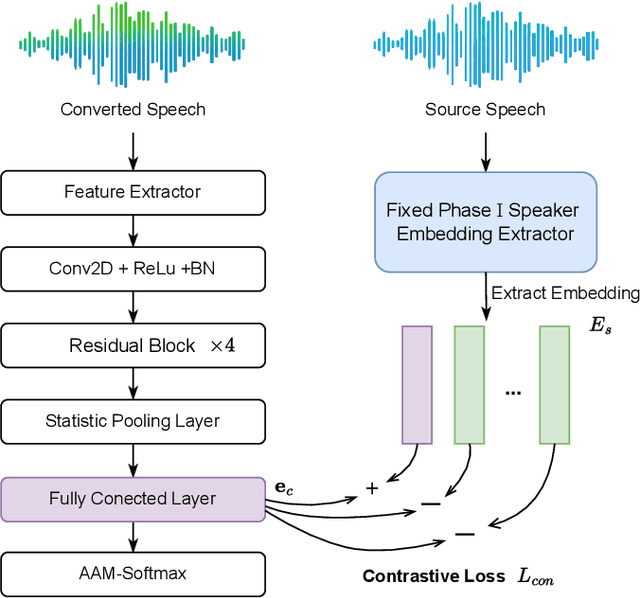

Abstract:As a form of biometric authentication technology, the security of speaker verification systems is of utmost importance. However, SV systems are inherently vulnerable to various types of attacks that can compromise their accuracy and reliability. One such attack is voice conversion, which modifies a persons speech to sound like another person by altering various vocal characteristics. This poses a significant threat to SV systems. To address this challenge, the Source Speaker Tracing Challenge in IEEE SLT2024 aims to identify the source speaker information in manipulated speech signals. Specifically, SSTC focuses on source speaker verification against voice conversion to determine whether two converted speech samples originate from the same source speaker. In this study, we propose a speaker contrastive learning-based approach for source speaker tracing to learn the latent source speaker information in converted speech. To learn a more source-speaker-related representation, we employ speaker contrastive loss during the training of the embedding extractor. This speaker contrastive loss helps identify the true source speaker embedding among several distractor speaker embeddings, enabling the embedding extractor to learn the potentially possessing source speaker information present in the converted speech. Experiments demonstrate that our proposed speaker contrastive learning system achieves the lowest EER of 16.788% on the challenge test set, securing first place in the challenge.
Rethinking the Output Architecture for Sound Source Localization
Nov 21, 2023
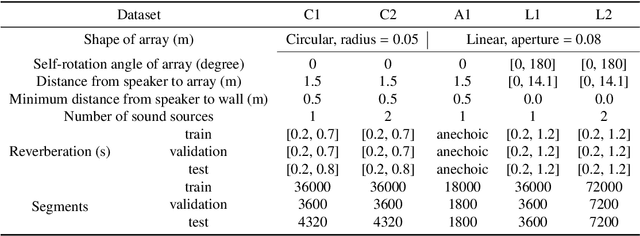

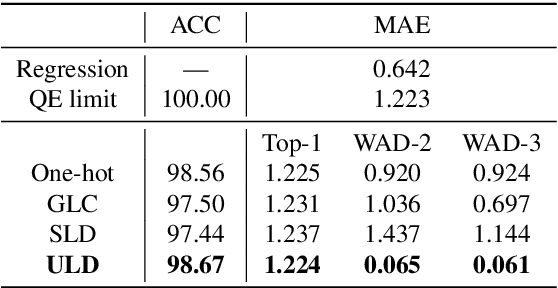
Abstract:Sound source localization (SSL) involves estimating the direction of arrival (DOA) of a sound signal. The output space of the DOA estimation is continuous, suggesting that regression may be the most appropriate formulation for DOA. However, in practice, converting the DOA estimation into a classification problem often results in better performance than the regression formulation, since that classification problems are generally easier to model, and are more robust in handling noise and uncertainty than regression problems. In the classification formulation of DOA, the output space is discretized into several intervals, each of which is treated as a class. These classes exhibit strong inter-class correlation, with their mutual-similarity increasing when they approach each other and being ordered. However, this property is not sufficiently explored. To exploit these property, we propose a soft label distribution, named Unbiased Label Distribution (ULD), for eliminating the quantization error of the training target and further taking the inter-class similarity into strong consideration. We further introduce two loss functions, named the Negative Log Absolute Error (NLAE) loss function and {Mean Squared Error loss function without activation (MSE(wo))}, for the soft label family. Finally, we design a new decoding method to map the predicted distribution to sound source locations, called Weighted Adjacent Decoding (WAD). It uses the weighted sum of the probabilities of the peak classes and their adjacent classes in the predicted distribution for decoding. Experimental results show that the proposed method achieves the state-of-the-art performance, and the WAD decoding method is able to even breakthrough the quantization error limits of existing decoding methods.
Diffusion-Based Adversarial Purification for Speaker Verification
Oct 24, 2023
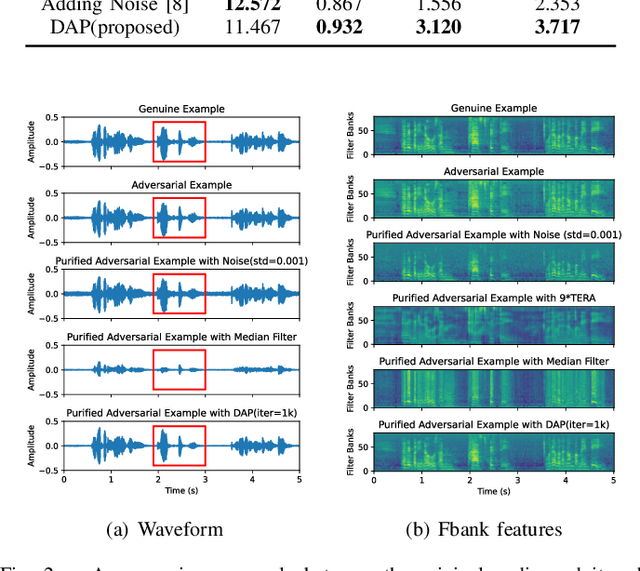


Abstract:Recently, automatic speaker verification (ASV) based on deep learning is easily contaminated by adversarial attacks, which is a new type of attack that injects imperceptible perturbations to audio signals so as to make ASV produce wrong decisions. This poses a significant threat to the security and reliability of ASV systems. To address this issue, we propose a Diffusion-Based Adversarial Purification (DAP) method that enhances the robustness of ASV systems against such adversarial attacks. Our method leverages a conditional denoising diffusion probabilistic model to effectively purify the adversarial examples and mitigate the impact of perturbations. DAP first introduces controlled noise into adversarial examples, and then performs a reverse denoising process to reconstruct clean audio. Experimental results demonstrate the efficacy of the proposed DAP in enhancing the security of ASV and meanwhile minimizing the distortion of the purified audio signals.
 Add to Chrome
Add to Chrome Add to Firefox
Add to Firefox Add to Edge
Add to Edge